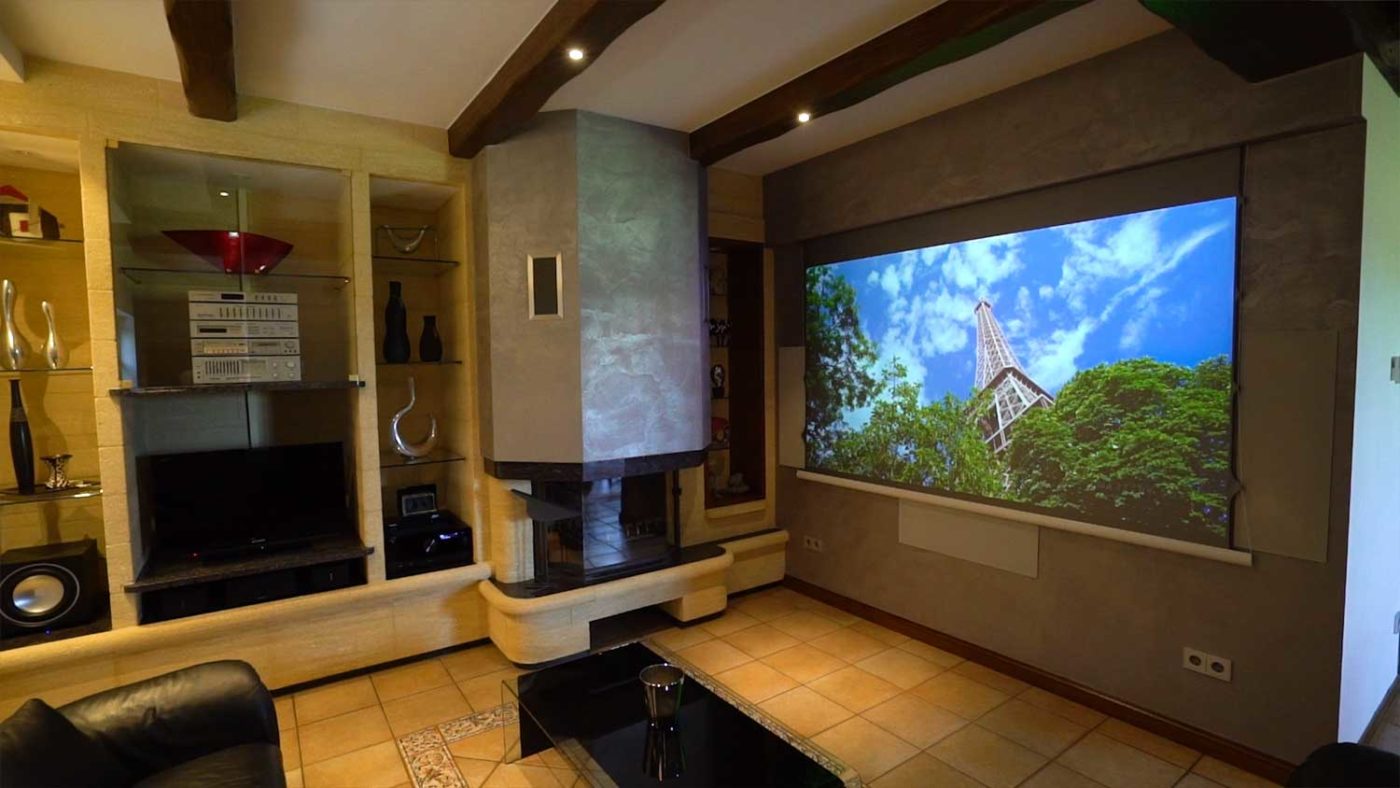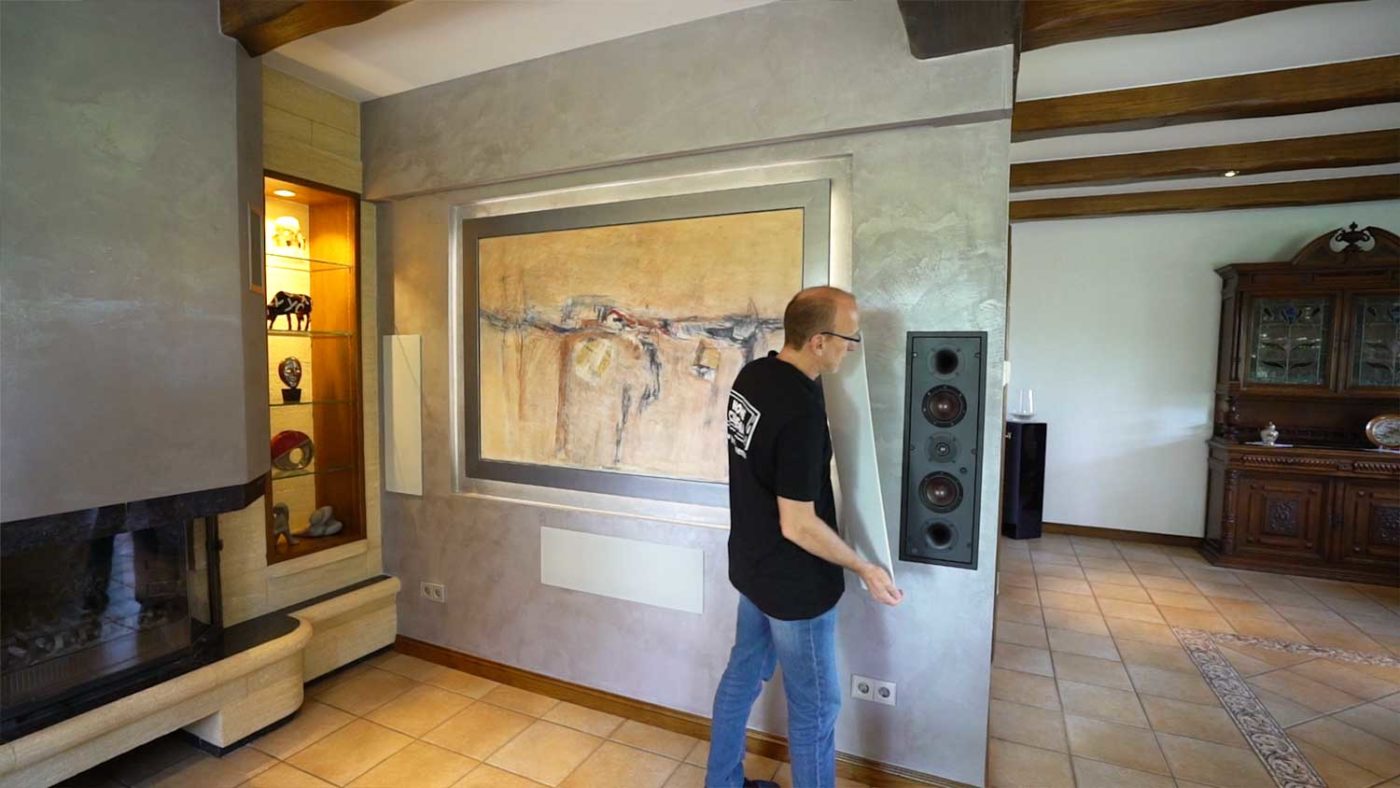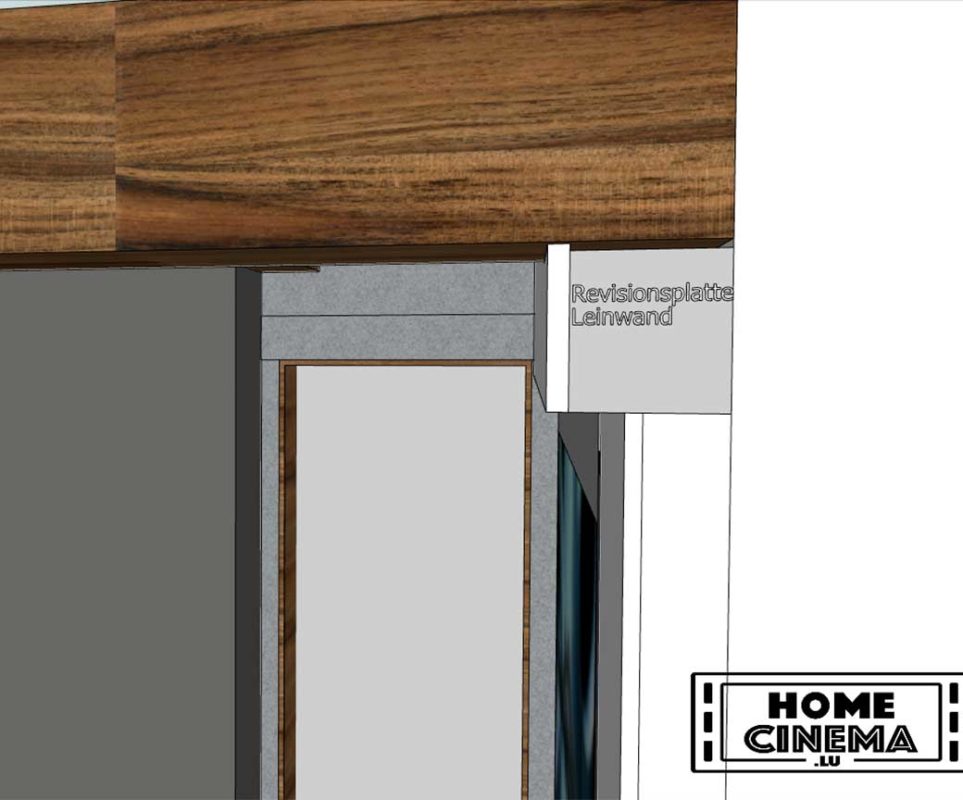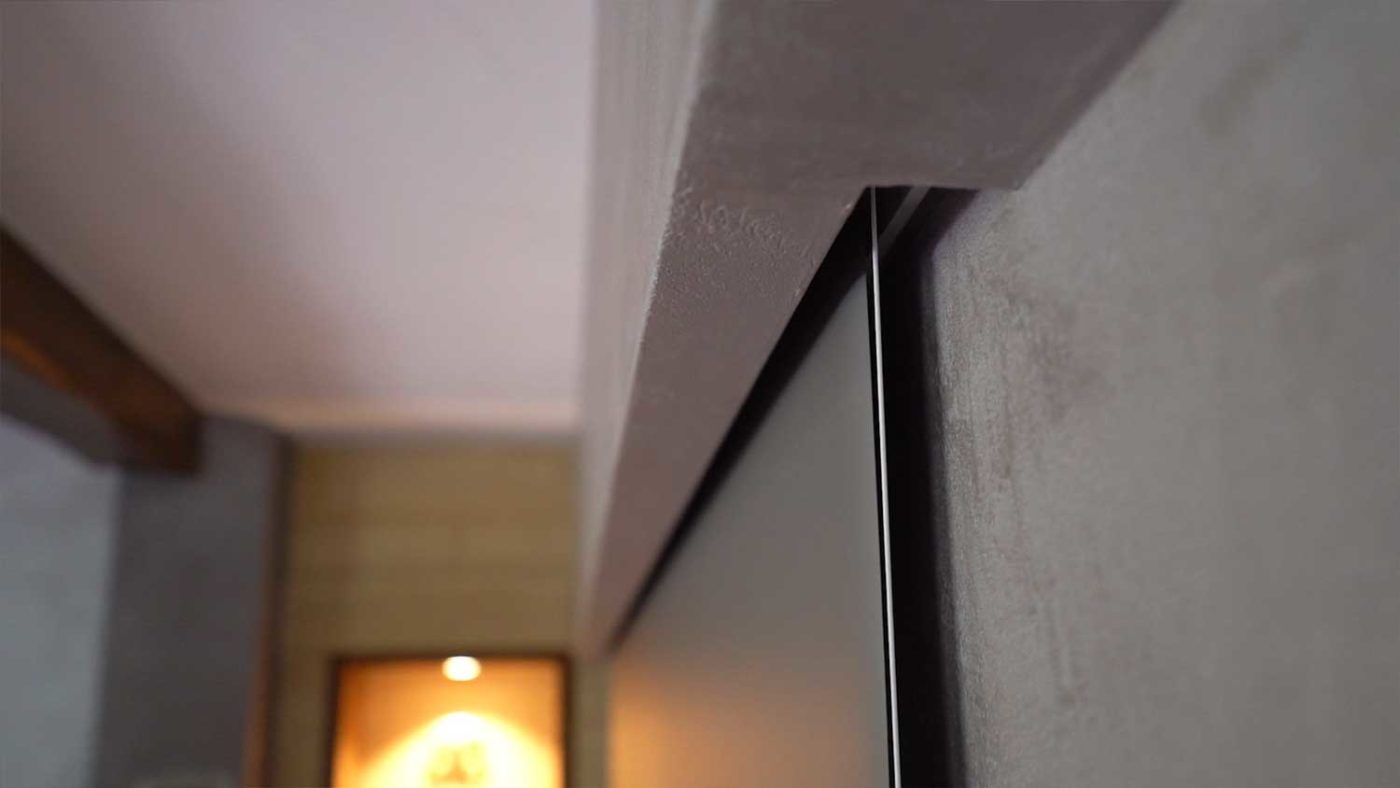We received a request from a customer asking whether it would be possible to integrate a home theater in the course of the upcoming renovation of a living room.
This task, integration of cinema in the living room, we have implemented very often in recent years, because if no separate room for a home theater is available, a living room has every customer. The special task for us here is to ensure that the integration is as invisible as possible, so that the cinema can only be seen when it is in operation.
We already received pictures and floor plan via mail and arranged a consultation appointment in our showrooms.
Even before the appointment, we checked a possible solution on the basis of the available data and then showed at the appointment in our extensive exhibition, only the technology that comes into question for this solution, such as projectors and speakers.

The customer wanted the screen and projector to disappear into the ceiling by motor. The ceiling should be suspended for this purpose.
After the costs for the technology, such as ceiling lift for the projector and recessed ceiling screen, but also of the ceiling construction were determined, it was decided, however, to refrain from this complex and costly conversion.
We should now consider other possibilities of integration of the home theater. For this purpose, after a measurement, we created an accurate 3D visualization and then checked various options for integration.
We then proposed a wall porch to integrate front speakers and a motorized screen. In the rear area, we proposed a slim ceiling enclosure to accommodate the projector and the two rear loudspeakers. Based on the 3D visualization, the customer was able to imagine this implementation very well and gave us the green light for further detailed planning.
Since the customer expressed the wish to design the new pre-wall completely with a spatula technique, another special task arose for us. For a built-in screen, there always has to be an inspection opening, such as one would find in a roller shutter. We therefore proposed a removable panel above the screen, but the customer did not like this because joints would be visible here and also posed a problem for the desired spatula technique.
So, of course, the customer’s wish and the technical necessity were not congruent from our point of view. So a solution had to be found here, because we work according to the motto “can’t be done, doesn’t exist”. We then examined alternatives and proposed to supply the screen via a small lateral revision, which pleased the customer, since a simple tapette covers the revision flap here.
For this purpose, we had the idea of converting the screen somewhat and using two rails on the wall to make the screen movable sideways. In this way, the screen can be removed laterally via a small inspection opening in case of an emergency. A large inspection opening with visible joints could therefore be dispensed with. Problem solved. Customer happy!
On the available wall, a picture was hung, which should continue to hold its ancestral place. So we planned a wall recess for the picture, so that the canvas can unwind in front of the picture. At the same time, we then set the scene for the picture by means of LED lighting. To simply place the screen a little further forward would have meant that the wall structure would have to be enlarged. Thus, the screen descends only a few mm in front of the wall.
Let’s move on to the opposite area of the room, where the projector and rear speakers were to be integrated. The customer had decided on the laser 4K projector, Epson LS11000. This now had to be integrated. Since there are wooden beams on the ceiling and the projector should of course be as high as possible on the ceiling, we had to check a few things in our 3D simulation. The result of the planning was that the envisaged box had to be built larger than desired, since we have to insert the projector at an angle for insertion. The beam is too close for a straight insertion.
We then adapted the drawing and took the result of the visualization into account in the planning and implementation. Then a customized casing for the projector and the speakers, as well as a few spots.
The subsequent cabling for screen, loudspeaker and projector, we were able to trace invisibly in wooden spaces of the beam structure. We checked this beforehand with a telescopic camera! We are world champions in the subsequent hiding of cables.

The entire wall structure around the fireplace is built of stone and we pulled the cables through cavities into a showcase area, which is now home to the technical center. The subwoofer should be in an open area of the showcases.
Now it was still a matter of operating the entire technology with one remote control, if possible. The customer wanted to get away from the previous variant of 6 remote controls, which he always had at hand in a box. We demonstrated our Control 4 control system to the customer in our exhibition, which convinced him. The NEEO system remote control and several control components from C4 were then used, with which we then realized a very simple control of the technology installed by us, as well as several lights and the previously existing small TV.


However, the TV has not been used since the arrival of the big screen. Who wants to look at a stamp when they have a cinema! However, a special feature of the Epson LS11000 is used here.
The projector is equipped with motorized optics and has the Lens Memory function, which makes it possible to store different image sizes and call them up by pressing a button on the remote control. In this way, the customer can watch the news as a “small” 65″ image on the screen, for example, in addition to the large cinema image. Since the screen is formatless, the viewer sees the image as properly masked.
Let’s briefly go over the technology used and why they are being used for this project.
The Screen:
Wir haben als Leinwand die Kontrast-Motorleinwand VNX Bright TV Dream in 2,23m Bildbreite (100“) gewählt.
Diese hat für uns gleich mehrere Vorteile für dieses Projekt mit sich gebracht.
We chose the VNX Bright TV Dream contrast motorized screen in 2.23m image width (100″).
This has brought several advantages for us for this project.
- Firstly, the contrast-optimizing properties of the screen fabric ensure a very vivid image even in daylight, which the customer was convinced of in our demo beforehand.
- The flatness is excellent and is guaranteed for a long time thanks to a rope tensioning system.
- The Dream version is a front-unwinding model, which for this project entails only a small amount of fronting of the casing, as the casing disappears towards the rear in the wall front. Only a small gap in our wall porch exposes the screen cloth.
- The screen is formatless, which always frames the image precisely, because the viewer sees the gray area as black when watching a movie, and the image is framed precisely even in 21:9 cinema formats. With a black 16:9 masking, as is normally the case, the unused image areas (black letterbox bars, as you know from television) would be clearly visible in 21:9 widescreen films. We always demonstrate this in our showroom and all customers are thrilled with the advantage of this screen.
In addition, the advantage already mentioned above, when using a projector with lens memory, with different image sizes in this project is an added value for the customer.

Speakers:
We wanted to plan a very good sounding, preferably invisible built-in speaker system in the pre-wall and recommended the Phantom M series from Dali. The Dali Phantom M-250 was then installed 3 times. The customer could listen to the M-375 beforehand in our demo.
The advantage of the M series here was also the compact, encapsulated design, of only 10cm installation depth. The grill can be painted in the wall color if desired. On the ceiling, the Phantom H60 are installed as rear and the subwoofer is the very compact but powerful Dali Sub E9.
Technique:
The Yamaha RX-A4A was chosen as the control center. Also because of the multi-room and music streaming system MusicCast, which will later be expanded into other areas of the house. All players from the customer’s inventory are connected here.

Controlling:
Control 4 EA1 control center, touch system remote control Neeo, as well as several switching and dimming actuators from C4. By the way, the system can also be operated by means of an app on a smartphone or tablet. There are versions for IOS and Android.

Beamer:
The Epson LS11000 is the ideal choice for this project as a 4K laser projector. Thanks to its extreme Lensshift and the very large zoom range, the positioning of the projector at the desired location was possible here. Lens memory is also utilized. The very sharp and bright image, coupled with the very good image processing such as intermediate image even in 4K, convinced here in the comparison. The projector is also white, which naturally scores points in the living room.

As you can see, there are a lot of details to consider when planning a home theater and sometimes even unusual ways lead to the goal.
With good pre-planning, mistakes can be avoided and the implementation can then be carried out in the best possible way.the result then provides many years of pleasure.a home theater is always a long-term acquisition and a gain in joy of life!
I hope you enjoyed our report about this customer project “Home Cinema Compact”. If you are also interested in your own home theater, we would be happy if you contact us. As you can see, we can also realize a post-installation in perfection.
Write to us or give us a call. We will be happy to arrange a non-binding consultation appointment with you and check whether we can implement your wishes in your own 4 walls.
Youtube-Video Heimkino Compact

 Deutsch
Deutsch













